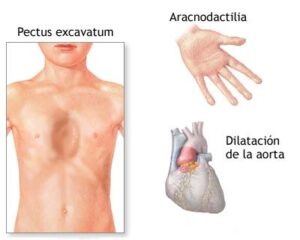
Marfan Syndrome and PGD (embryo genetic diagnosis)
We now can avoid the transmission to offspring with the PGD techniques (embryo’s Pre-implantation Genetic Diagnosis) also called PGT-M
Índice
Symptoms and causes of Marfan syndrome
The connective tissue serves to hold together body tissues and cells. As a result, the result of Marfan syndrome is abnormalities in blood vessels, eyes, lungs, bones and the heart. The main symptoms are:
- Therefore a high forehead and long limbs as well as long
- thin fingers
- pectus carinatum
- flat feet
- a narrow face, a small
- and thin jawline, loose joints, and eye and cardio-vascular disorders.
In most cases, the syndrome is caused by mutations in the FBN1 gene on chromosome 15. The FBN1 gene that encodes the protein fibrillin is a major component of connective tissue. When this is damaged, certain structures break down, like blood vessels.
Marfan Syndrome diagnosis

The initial diagnosis of Marfan syndrome is completed by evaluating the signs and symptoms. Nevertheless a genetic study is needed to conclude with certainty the clinical diagnosis. The study provides information about the responsible genetic mutation causing the disease. Having identified the mutation it is then possible to carry out prevention so that subsequent generations are not affected, as well as studies of other family members to see whether they are affected and to what degree.
Avoid the Marfan syndrome transmission
It is a genetic syndrome, passed down from generation to generation and more specifically is inherited as autosomal dominant, i.e. the probability of transmission is 50%, regardless of gender. As an example, an affected individual with 4 children would have the probability of two of their children being affected by the syndrome. and two healthy although the probability does not indicate absolute terms whereas the other two would be healthy although this is not absolute. This means that perhaps all 4 would be affected or none at all. And so, in most cases, the affected parent has at least one off-spring that is also affected by the syndrome.
In 20% of all cases the parents are unaffected and the syndrome is due to the emergence of a de novo mutation in the FBN1 gene. That person has then a 50% chance of passing the syndrome to his or her offspring. The incidence of the syndrome is 1 in 10,000 people.
The only way to ensure healthy, biological offspring of individuals affected by Marfan syndrome is for them to undergo prenatal or preimplantation diagnosis (PGD) which allows us to select healthy embryos which are then transferred into the uterus, allowing the birth of healthy children free of Marfan syndrome.
Instituto Bernabeu has many years’ experience in PGD and has pioneered the birth of children free of Marfan syndrome.
Dra Belén Lledó, Molecular Biologist and medical director of IBBIOTECH Instituto Bernabeu Group.
